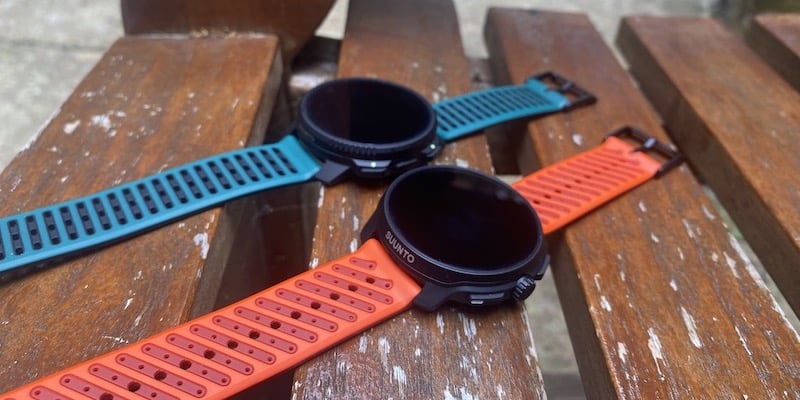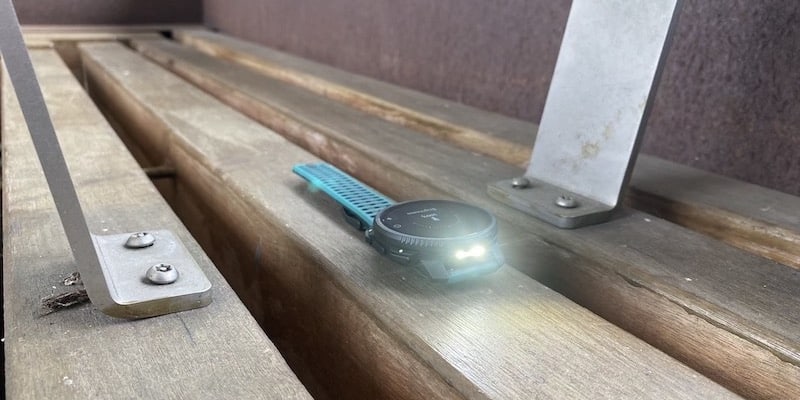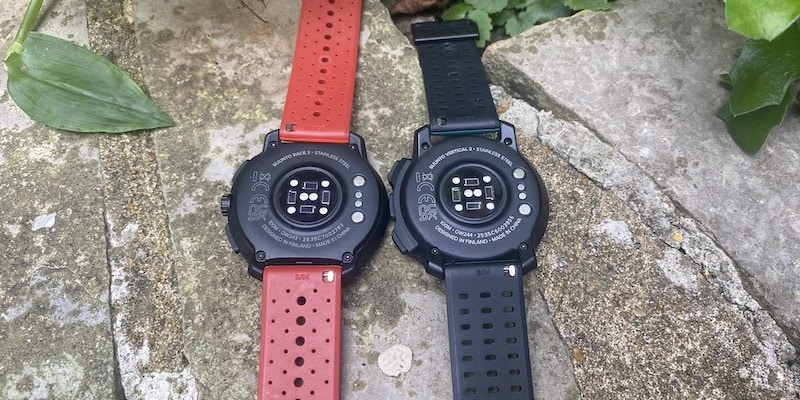
Five key differences between Suunto Vertical 2 vs Race 2 explained
Suunto has dropped two proper flagship watches over the past couple of months, and both are packing serious features. The Vertical 2 is built like a tank, with long battery life and even a built-in flashlight. The Race 2 strips things back a bit, going lighter and slimmer, but still holds its own with the same dual-band GPS, heart rate sensor and AMOLED display.
They share a lot under the hood, but they feel different on the wrist. You can check out my Vertical 2 review for the full breakdown. I’m also testing the Race 2, and that review will drop in the next few days.
Here is a no nonsense look at the 5 key differences separating Suunto Vertical 2 and Race 2.
View on Suunto / Amazon (Vertical 2 / Race 2)
Vertical 2 is thicker and heavier
Both watches share the same 49mm case size, but the Vertical 2 has more heft. Its stainless steel or titanium build feels more rugged, with an outdoors-first design that doesn’t try to be slim or minimal. The Race 2 trims things down with plastic lugs and case sides, giving it a sportier feel.
Vertical 2 is also thicker, at 13.5mm compared to 12.5mm for the Race 2. The weight difference is noticeable too. The steel version of Vertical hits 87 grams with the strap, while the titanium model drops to 74. Race 2 lands at 76 grams for steel and just 65 for titanium.
If you’ve got slimmer wrists, the Race 2 wears more comfortably. Vertical 2 is better suited to medium or larger wrists. That said, neither watch feels huge. Suunto has kept the design balanced enough that both are still wearable day to day. But I’d say Race 2 is more unisex and Vertical 2 is more masculine.

Button layout is different
Suunto takes a different approach with controls on these two watches. Vertical 2 uses a familiar three-button layout on the right side. It’s simple, reliable and works well even with gloves or sweaty hands. Race 2 swaps in a rotating crown paired with two flat buttons. It feels more modern and offers smoother scrolling through menus, but it is less glove-friendly. In everyday use, the crown gives Race 2 the edge in usability. That is, unless you are out in the cold.
Both watches feature a 1.5 inch AMOLED display with 466×466 resolution. Brightness is up to 2,000 nits, making it easy to read even in strong sunlight. Maps look sharp, workout screens pop and visibility is excellent across conditions.
Suunto seems to be moving away from MIP screens. Not everyone will agree with this, but AMOLED is easier on the eyes and probably cheaper to produce. Also, that type of screen is no longer a battery drain.

The flashlight gives Vertical 2 an edge in the dark
One thing the Vertical 2 has that the Race 2 doesn’t is a proper LED flashlight. It’s built into the top edge of the case and shines forward like a real torch, not just a white screen. You can turn it on with a shortcut, and once you start using it, you’ll probably wonder how you managed without it. Whether you’re out on a trail, getting up at night, or just looking for something behind the sofa, it’s genuinely useful.
You get a few brightness levels, a red mode for night vision, and even an SOS flash if you want to get fancy. It can run during workouts, although switching it on mid-activity takes a few extra taps. Still, it’s a handy tool that comes in more useful situations than you’d expect.
The Race 2 leaves it out completely. You just get the screen light option of the past generation. That keeps things slimmer and lighter, but you lose what’s easily one of the most practical extras Suunto has added in a while. If you do a lot of outdoor stuff, the flashlight alone might be enough to sway you.

Battery life differences are there, but not huge
On paper, both watches deliver excellent endurance, especially with dual-band GPS enabled. But the Vertical 2 edges slightly ahead in every mode. You get up to 20 days in smartwatch mode compared to 18 on the Race 2. Standby time stretches to 40 days for the Vertical, while the Race tops out at 30.
In training modes, the gap is a bit more noticeable. With all-systems GNSS and multi-band enabled, the Vertical manages up to 65 hours, while the Race comes in at 55. Switch to single-band, and that bumps up to 75 and 65 hours respectively. If you really want to push it, power-saving GNSS extends things to 250 hours on the Vertical and 200 on the Race.

Suunto also offers multiple power modes for workouts. On the Vertical 2, you can switch between Performance, Endurance, Ultra and Tour to manage battery on the fly. The Race 2 supports the same modes, but with slightly lower figures across the board. These tweaks add flexibility depending on your activity and how long you plan to be out.
In practice, the Vertical 2 lasts a couple of days longer with mixed use. That margin might not matter for everyone, but if you go long between charges or head off-grid often, it gives you some breathing room.
Here is the detailed battery life comparison.
Battery life mode | Suunto Vertical 2 | Suunto Race 2 |
|---|---|---|
Daily use: Smartwatch mode | up to 20 days | up to 18 days |
Daily use: Standby time mode only | up to 40 days | up to 30 days |
Training: All-Systems GNSS + Multi-Band | up to 65h | up to 55h |
Training: All-Systems GNSS + Single-Band | up to 75h | up to 65h |
Training: All battery modes battery promises | 65h / 75h / 110h / 250h | 55h / 65h / 90h / 200h |
Training: Power saving GNSS modes | up to 250h | up to 200h |
Vertical 2 costs more, but not by much
Price is another thing to think about. The stainless steel version of the Vertical 2 goes for $600, and if you want the titanium model, that bumps it up to $700. Race 2 is a bit cheaper. You’re looking at $500 for stainless steel and $600 for titanium.
So the difference is about $100 between the two watches at each level. If you want the lighter build or the extra features like the flashlight, the Vertical 2 might justify the extra spend. But if your focus is training and you don’t need all the outdoor extras, Race 2 gives you most of what matters for less.
Vertical 2 aims for the outdoors, Race 2 for training
These two watches are built for different kinds of users. Vertical 2 is clearly meant for the outdoors. It’s tough, has longer battery life, and includes a proper LED flashlight. It’s the kind of watch you want on your wrist when you’re out hiking, running trails or travelling off the grid.
Race 2 is more about performance. It’s lighter, slimmer and easier to wear if you’ve got smaller wrists. The digital crown makes scrolling quicker, and the overall setup feels more tuned for runners or triathletes who don’t need all the extras.
Both watches use the same dual-band GNSS and optical heart rate sensor. I tested the Vertical 2 alongside a Garmin in central London and it tracked really well, even in tricky GPS spots. Heart rate was also close, as long as the watch was fitted high enough on the wrist. If it slips too low, accuracy can drop, especially on smaller wrists.
Race 2 stays in place better because it weighs less. That helps with heart rate accuracy during movement. Since both share the same tracking tech, you’re not giving up anything in terms of performance. If you’re coming from Garmin or Coros, you’ll feel right at home.
Neither of these is trying to be a full-on smartwatch. There’s no music storage, no contactless payments and no app store. You still get notifications, media controls and weather, but that’s about it.
The choice really comes down to how you train. If most of your time is spent chasing pace, Race 2 makes more sense. If you want something that can handle big adventures, the Vertical 2 is worth the extra weight.
View on Suunto / Amazon (Vertical 2 / Race 2)
Subscribe to our monthly newsletter! Check out our YouTube channel.
And of course, you can follow Gadgets & Wearables on Google News and add us as a preferred source to get our expert news, reviews, and opinion in your feeds.
